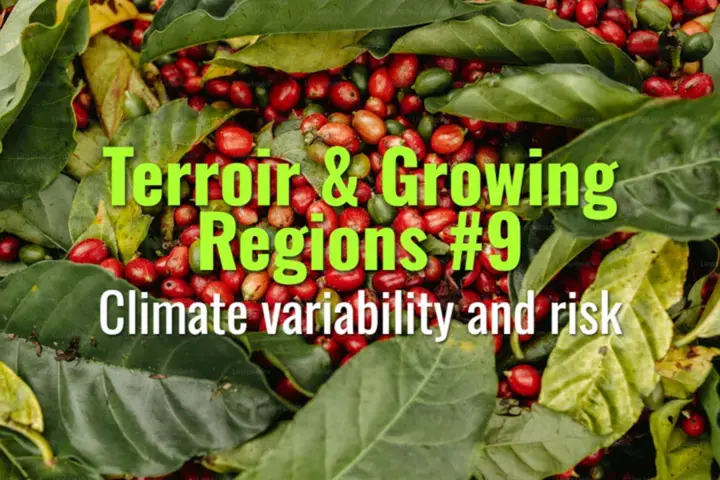Climate variability and risk
This topic explores how climate variability and long-term climate change affect coffee production, the risks farmers face, and the strategies being developed to adapt and ensure sustainability.
- Coffee Basics Nerds
- 2 min read
Article 9 of 12 in Terroir & Growing Regions/

Coffee’s Climate Sensitivity
- Coffee, especially Arabica, is highly sensitive to temperature, rainfall, and humidity changes.
- Narrow optimal range: Arabica thrives at 18–22°C; Robusta at 22–30°C.
- Small deviations can reduce yield, alter flavor, or trigger disease outbreaks.
Key Climate Risks
1. Rising Temperatures
- Accelerates cherry maturation → smaller beans, lower density.
- Reduces complexity and acidity in Arabica.
- Expands pest and disease ranges (e.g., coffee leaf rust, coffee berry borer).
2. Erratic Rainfall
- Delayed or unpredictable rains disrupt synchronized flowering.
- Droughts cause flower abortion, fruit drop, and yield loss.
- Heavy rains during harvest damage drying and increase mold risk.
3. Frost Events
- Rare but devastating in high-altitude regions like Brazil’s Minas Gerais.
- Can kill entire plantations overnight.
4. Extreme Weather
- Hurricanes, floods, and landslides damage infrastructure and farms.
- Soil erosion reduces long-term fertility.
Regional Vulnerability
- Latin America: Arabica at risk from rising heat and erratic rains.
- Africa: Traditional origins (Ethiopia, Kenya) threatened by drought and deforestation.
- Asia-Pacific: Vietnam’s Robusta resilient to heat but vulnerable to water scarcity.
Farmer Adaptation Strategies
- Shade management: Trees buffer temperature extremes.
- Irrigation & water conservation: Drip irrigation, mulching, and rainwater harvesting.
- Soil health: Organic matter and cover crops reduce erosion and improve resilience.
- Variety selection: Adoption of hybrids and disease-resistant cultivars.
- Diversification: Farmers diversify income (fruit trees, honey, other crops).
Global Research & Policy Response
- Breeding programs for climate-resilient varieties (F1 hybrids, rust-resistant cultivars).
- International initiatives (World Coffee Research, ICO) monitoring risks and sharing solutions.
- Certifications (Rainforest Alliance, Fairtrade) promoting adaptation practices.
Lasting Importance
Climate variability poses one of the greatest existential risks to coffee. Arabica could lose up to 50% of its suitable land by 2050 if no adaptation occurs. Building resilience through smart farming, improved varieties, and global collaboration is essential to safeguard coffee’s future.
You might also like:
- Tags:
- Lasting Importance
- Organic Matter
- Rainforest Alliance
- Latin America
- High Altitude
- Leaf Rust
- Coffee Leaf
- Shade Management
- Soil Health
- World Coffee
- Highly Sensitive
- Berry Borer
- Breeding Programs
- Coffee Research
- Coffee Berry
- Pest Disease
- Cover Crops
- Mold Risk
- Cherry Maturation
- Climate Variability
- Smaller Beans
- Water Conservation
- Disease Resistant
- Ethiopia Kenya
- Rust Coffee
- Reduce Yield
- Beans Lower
- Rising Temperatures
- Erratic Rainfall